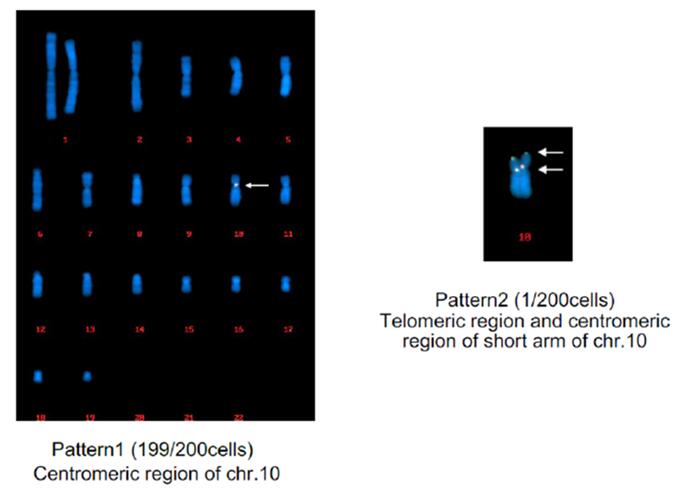CHO Cell Line Clonality Assessment
Creative Bioarray provides the genetic characterization of (CHO) producer cell lines by Fluorescent In Situ Hybridization (FISH), which offers information on transgene integrity and integration sites. We have assessed a method for assessing clonality, based on a FISH-DNA platform, by detecting the specific location of the integrated recombinant transgene at the chromosomal level. In the case where all FISH patterns found in the MCB are identical, the cell line is clonal in origin. However, the presence of two or more different FISH patterns indicates that either:
- the cell line is nonclonal in origin
- or chromosomal rearrangement has occurred during propagation.
This FISH method allows for analysis of single cells to assess the homogeneity within the parental population.

Here, we have established a high-throughput clonality analysis (FISH) strategy to fast-track your stable cell line development and accelerate subsequent IND review. Creative Bioarray has provided the CHO Cell Line Clonality Assessment FISH Services for numerous pharmaceutical companies, and successfully helped their biopharmaceutical products get approved by the regulatory agency.
Recombinant protein therapeutics, or biologics, are an important class of pharmaceuticals for which Chinese Hamster Ovary (CHO) cells are the most commonly used expression system. Assessment of clonality remains a key factor in the development of any new stable cell lines for novel biopharmaceuticals or biosimilars.
Recently, proof of clonality has become a focus since many companies have received revisions back on this topic during the Investigational New Drug (IND) review process of their biological products. Clonality is thought to minimize the heterogeneity of cell banks and thus allow for consistent manufacture a product. Here, Creative Bioarray has established a high-throughput clonality analysis strategy, Fluorescence in Situ Hybridization (FISH), to fast-track your stable cell line development and accelerate subsequent IND review.
There are regulatory considerations regarding the clonal derivation of the cell line used to create the master cell bank (MCB). Even though no single regulatory guidance announces publicly and definitively about the need of having a demonstrably "clonally derived" cell line, multiple guidance documents allude to this general expectation and underscore it as a basic expectation. These include, but are not limited to:
- ICH Q5D Derivation and Characterization of Cell Substrates Used for Production of Biotechnological/Biological Products states that: "For recombinant products, the cell substrate is the transfected cell containing the desired sequences which has been cloned from a single cell progenitor"
- US FDA Points to Consider in the Manufacture and Testing of Monoclonal Antibody Products for Human Use notes that "The MCB is defined as a collection of cells of uniform composition derived from a single tissue or cell"
- EMA/CHMP guidance which notes "The cell substrate to be used for the production of the monoclonal antibodies should be a stable and continuous monoclonal cell line that has been developed by means of recombinant DNA and/or other suitable technologies".
Creative Bioarray's CHO Cell Line Clonality Assessment Service has the following Features:
- Detection of each individual integration site
- Analyze 100-200 cells per sample
- Rapid 4-week turnaround time, including addition reporting
- High accuracy and sensitively
- Competitive pricing
Creative Bioarray offers CHO Cell Line Clonality Assessment Service for your project as follows:
- Probe design
- Probe synthesis
- Chromosome spread preparation
- FISH on chromosome spreads Imaging
- Data analysis (karyotyping and integration pattern analysis)
Quotation and ordering
Our customer service representatives are available 24hr a day! We thank you for choosing Creative Bioarray as your preferred CHO Cell Line Clonality Assessment Service provider.
References
- Frye, Christopher, et al. "Industry view on the relative importance of "clonality" of biopharmaceutical-producing cell lines." Biologicals 44.2 (2016): 117-122.
- Wurm, Florian M., and Maria João Wurm. "Cloning of CHO cells, productivity and genetic stability—a discussion." Processes 5.2 (2017): 20.
- ICH Q5D Derivation and characterisation of cell substrates used for production of biotechnological/biological products (CPMP/ICH/294/95)
- Welch, J. (2017). Tilting at clones: A regulatory perspective on the importance of "Clonality" of mammalian cell banks. CDER/OPQ/OBP/DBRRIV April 24, 2017.
- Paul Wu, et al. "Tools and methods for providing assurance of clonality for legacy cell lines" in "Cell Culture Engineering XVI", A. Robinson, PhD, Tulane University R. Venkat, PhD, MedImmune E. Schaefer, ScD, J&J Janssen Eds, ECI Symposium Series, (2018).
- Wu P, Hartman T, Almond L, Stevens J, Thrift J, Ojha J, Alves C, Shaw D, Laird MW, Emmins R, Zhu Y, Liu R, Du Z, Koehler R, Jostock T, Anderson K, Campbell C, Clarke H. Advancing Biologics Development Programs with Legacy Cell Lines: Advantages and Limitations of Genetic Testing for Addressing Clonality Concerns Prior to Availability of Late Stage Process and Product Consistency Data. PDA J Pharm Sci Technol. 2020 Mar-Apr;74(2):264-274. doi: 10.5731/pdajpst.2018.009316. Epub 2019 Sep 13. PMID: 31519780.
All products and services on this website are only suitable for non-medical purposes.






